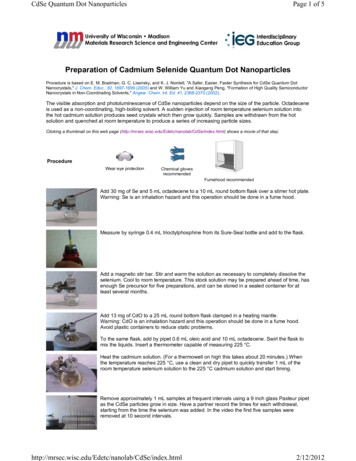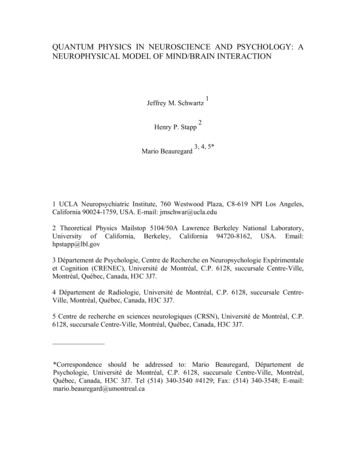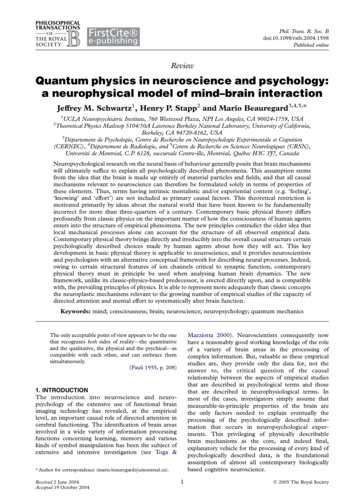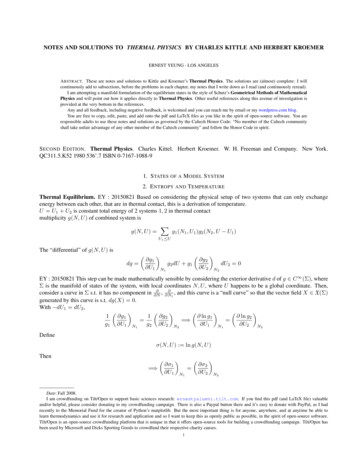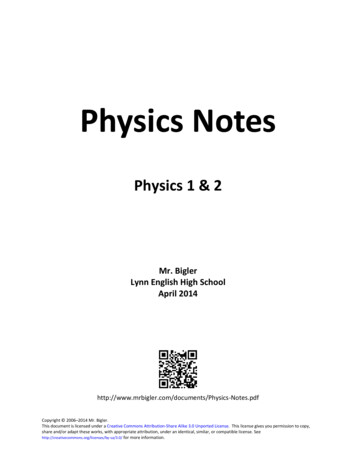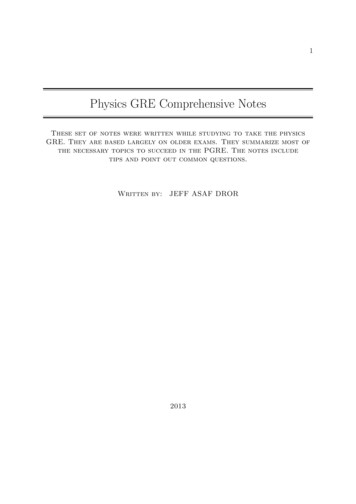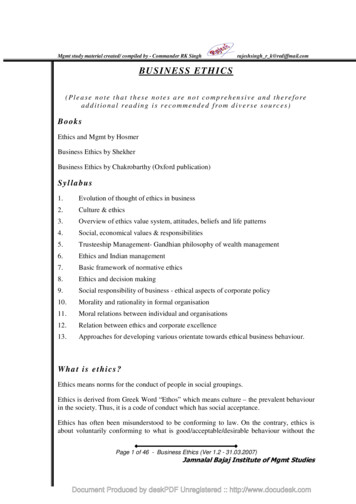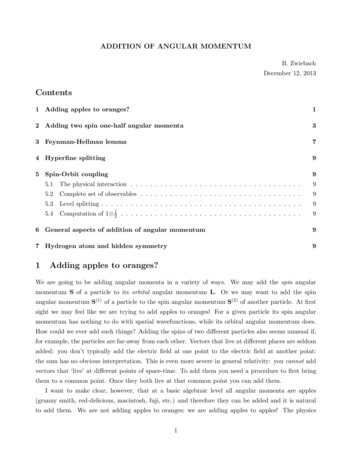
Transcription
ADDITION OF ANGULAR MOMENTUMB. ZwiebachDecember 12, 2013Contents1 Adding apples to oranges?12 Adding two spin one-half angular momenta33 Feynman-Hellman lemma74 Hyperfine splitting95 Spin-Orbit coupling95.1The physical interaction . . . . . . . . . . . . . . . . . . . . . . . . . . . . . . . . . . .95.2Complete set of observables . . . . . . . . . . . . . . . . . . . . . . . . . . . . . . . . .95.3Level splitting . . . . . . . . . . . . . . . . . . . . . . . . . . . . . . . . . . . . . . . . .95.4Computation of1 12. . . . . . . . . . . . . . . . . . . . . . . . . . . . . . . . . . . . .96 General aspects of addition of angular momentum97 Hydrogen atom and hidden symmetry91Adding apples to oranges?We are going to be adding angular momenta in a variety of ways. We may add the spin angularmomentum S of a particle to its orbital angular momentum L. Or we may want to add the spinangular momentum S(1) of a particle to the spin angular momentum S(2) of another particle. At firstsight we may feel like we are trying to add apples to oranges! For a given particle its spin angularmomentum has nothing to do with spatial wavefunctions, while its orbital angular momentum does.How could we ever add such things? Adding the spins of two different particles also seems unusual if,for example, the particles are far-away from each other. Vectors that live at different places are seldomadded: you don’t typically add the electric field at one point to the electric field at another point:the sum has no obvious interpretation. This is even more severe in general relativity: you cannot addvectors that ‘live’ at different points of space-time. To add them you need a procedure to first bringthem to a common point. Once they both live at that common point you can add them.I want to make clear, however, that at a basic algebraic level all angular momenta are apples(granny smith, red-delicious, macintosh, fuji, etc.) and therefore they can be added and it is naturalto add them. We are not adding apples to oranges; we are adding apples to apples! The physics1
requires it: we will see that energy eigenstates will also be eigenstates of operators in the sum ofangular momenta. The mathematics allows it: the sum of angular momenta is an angular momentumacting in the appropriate tensor product. As we will see below, each angular momentum lives on adifferent vector space, but the sum finds a home in the tensor product of the vector spaces.What is an angular momentum? It is a triplet Jˆi of Hermitian linear operators on some complexvector space V satisfying the commutation relations[Jˆi , Jˆj ] in ǫijk Jˆk .(1.1)As we have learned, this is a very powerful statement. When coupled with the requirement that nonegative norm-squared states exist, it implies that V can be decomposed into sums of representationsof angular momentum, all of which are finite dimensional.Let us now assume we have two angular momenta:(1)acting on V1 and satisfying [Jˆi(2)acting on V2 and satisfying [JˆiHermitian operators JiHermitian operators Ji(1)(1)(1), Jˆj ] in ǫijk Jˆk(2)(2)(2), Jˆj ] in ǫijk Jˆk(1.2)Our claim is that the ‘sum’ of angular momenta is an angular momentum in the tensor product:(1)(2)Jˆi Jˆi 1 1 Jˆi satisfies [Jˆi , Jˆj ] in ǫijk Jˆk acting on V1 V2 .(1.3)Certainly the sum operator, as defined above, is an operator on V1 V2 . It is in fact a Hermitianoperator on V1 V2 . We just need to check that the commutator holds[ (1)(2)(1)(2) ][Jˆi , Jˆj ] Jˆ 1 1 Jˆ , Jˆ 1 1 Jˆiijj(1)(1)(2)(2) ] Jˆi 1 , Jˆj 1 1 Jˆi , 1 Jˆj,[](1.4)[since the mixed terms, which represent commutators of the operators in the different spaces vanish:[(1)(2)Jˆi 1 , 1 Jˆj ] 0 ,[(2)(1)1 Jˆi , Jˆj 1 ] 0 .(1.5)(If this is not ‘obvious’, think about it and do the one-line computation that will make it obvious!).Writing out the commutators we see that (1.4) becomes[ (1) (1) ][ (2) (2) ] 1 1 Jˆi , Jˆj.[Jˆi , Jˆj ] Jˆi , Jˆj(1.6)We can now use the independent algebras of angular momentum to find(1)(2)[Jˆi , Jˆj ] in ǫijk Jˆk 1 in ǫijk 1 JˆkU (1)(2) ) in ǫijk Jˆk 1 1 Jˆk in ǫijk Jˆk ,which is what we set out to prove.2(1.7)
It is important to note that had we added the two angular momenta with some arbitrary coefficientswe would not have got an angular momentum. Indeed, suppose we use two non-zero complex constantsα and β and write(1)(2)J i α Jˆj 1 β 1 Jˆj .(1.8)If either constant is zero we are not really summing. The commutator calculation above this timeyieldsU(1)(2) )[J i , J j ] in ǫijk α2 Jˆk 1 β 2 1 Jˆk .(1.9)We have an algebra of angular momentum if the operator in parenthesis is J k . This requires α2 αand β 2 β. Since neither α nor β is zero, the only solution is α β 1. This confirms that we areusing in (1.3) the unique way to add two angular momenta to form a new angular momentum.By the same arguments that hold for any angular momentum on a vector space, the space V1 V2can be decomposed into sums of representations of the algebra of total angular momentum. Thisproperty gives us a powerful tool to understand the spectrum of the Hamiltonian in the physical statespace V1 V2 .2Adding two spin one-half angular momentaTo set up the notation recall that for a spin one-half particle and spin operators S we writeS2 s, m) n2 s(s 1) s, m) ,Sˆz s, m) nm s, m) ,with s 12, and m 12 .(2.1)The states that span the vector space are thus 12 , 12 ) , 12 , 21 ) ,(2.2)states that we used to label as ) and ), respectively. The action of S2 on any of these states gives3 24nand the action of Ŝz /n gives12on the first and 12 on the second.We now consider the case in which our system features two spin one-half particles. For the firstparticle we have the triplet of spin operators S(1) acting on the vector space V1 spanned by 12 , 12 )1 , 12 , 21 )1 ,(2.3)For the second particle we have the triplet spin operators S(2) acting on the vector space V2 spanned by 12 , 12 )2 , 12 , 21 )2 .(2.4)We now form the total spin(1)Ŝi Ŝi(2) 1 1 Ŝi(2.5)which we write, for brevity as(1)(2)Sˆi Sˆi Ŝi , for example, Sˆz Ŝz(1) Sˆz(2) ,3(2.6)
with the understanding that each operator on the right-hand sides acts on the appropriate factor inthe tensor product. The state space for the dynamics of the two particles must contain the tensorproduct V1 V2 (more spaces might be needed if the particles have orbital angular momentum or theyare moving). As we learned before, V1 V2 is a four-dimensional complex vector space spanned bythe products of states in (2.3) and (2.4): 12 , 21 )1 12 , 21 )2 , 12 , 21 )1 12 , 21 )2 , 12 , 21 )1 12 , 21 )2 , 12 , 21 )1 12 , 21 )2 .(2.7)It must be possible to organize these states into finite-dimensional representations of the total spinangular momentum, which is well-defined acting on these states. We have four basis states so thepossibilities for multiplets of total spin s are1. Four singlets (s 0).2. Two doublets (s 12 ).3. One doublet (s 12 ) and two singlets (s 0).4. One triplet (s 1) and one singlet (s 0).5. One s 32multiplet.It may be instructive at this point if you pause to make sure no other option exists and then to considerwhich option is the only likely to be true! Guess it!The main clue is that the states in the tensor product are eigenstates of Ŝz , the total z-componentof angular momentum. We see by inspection of (2.7) that the possible values of Ŝz /n and 1, 0, and 1. Since we have a state with m 1 and no state with higher m we must have a triplet s 1.Thus the only option is the fourth one listed above: a triplet and a singlet. This is written as(s 12 ) (s 12 ) (s 1) (s 0)(2.8)Note that in the left-hand side we have the tensor product of the two state spaces, but in the right-handside the direct sum of the representations of total spin angular momentum. This is a fundamentalresult and is written more briefly as12 12 1 0.(2.9)Let us understand this very explicitly by organizing the basis states according to the eigenvalue mof Ŝz /n. We readily observe thatm 1: 12 , 12 )1 21 , 12 )2 ,m 0: 12 , 12 )1 12 , 21 )2 ,m 1 : 12 , 21 )1 12 , 21 )2 .4 12 , 21 )1 12 , 21 )2 ,(2.10)
We see that we get two states with m 0. This is as it should be. One linear combination of thesetwo states must correspond to the m 0 state of the triplet and another linear combination mustcorrespond to the singlet s m 0. Those two states are in fact entangled states. Denoting by s, m)the eigenstates of S2 and Ŝz (total spin) we must have a triplet with states 1, 1) 12 , 12 )1 12 , 12 )2 , 1, 0) α 12 , 12 )1 12 , 12 )2 β 12 , 12 )1 12 , 12 )2 ,(2.11) 1, 1) 12 , 12 )1 12 , 12 )2 .for some constants α and β, as well as a singlet 0, 0) γ 12 , 12 )1 12 , 12 )2 δ 12 , 12 )1 12 , 12 )2 ,(2.12)for some constants γ and δ. We must determine these four constants. Let us begin with the state inthe triplet. Recalling the general formulaJJ j, m) n j(j 1) m(m 1) j, m 1)(2.13) J 1, 1) n 2 1, 0) ,JJ 12 , 12 ) n 12 · 32 12 · ( 12 ) 12 , 12 ) n 12 , 12 )JJ 12 , 12 ) n 12 · 32 ( 12 ) · ( 12 ) 12 , 12 ) n 12 , 12 )(2.14)we quickly note that(1)(2)In here J can be spin, of course. We now apply the lowering operator S S S to the topstate in the triplet. We have(1)(2)S 1, 1) (S 12 , 12 )1 ) 12 , 12 )2 12 , 12 )1 (S 12 , 12 )2 ) ,(2.15)Using the results in (2.14) we find 2n 1, 0) n 12 , 12 )1 12 , 12 )2 12 , 12 )1 n 12 , 12 )2 .(2.16)Cancelling the common factors of n and switching the order of the terms we find that the 1, 0) statetakes the form 1, 0) 12 12 , 12 )1 12 , 12 )2 12 , 12 )1 12 , 12 )2 .(2.17)Having found the m 0 state of the s 1 multiplet there are a number of ways of finding the m 0of the s 0 singlet. One way is orthogonality: the latter state must be orthogonal to the m 0state above because these are two states with different s, thus different eigenvalues for the Hermitianoperator S2 . Since the overall sign or phase is irrelevant, we can simply take for the singlet 0, 0) 12 12 , 12 )1 12 , 12 )2 12 , 12 )1 12 , 12 )2 .5(2.18)
You probably remember that we found this state in a previous chapter by requiring that it is annihilatedby the sum of spin angular momentum operators. This is exactly the condition for a singlet.As an interesting calculation and good practice with the operators, let us confirm that S2 is zeroacting on 0, 0). For this it is useful to note thatS2 (S(1) S(2) )2 (S(1) )2 (S(2) )2 2S(1) · S(2)(1) (2)(1)(2) (S(1) )2 (S(2) )2 S S S S 2Sz(1) Sz(2)(2.19)where in the second step we used the general resultĴ(1) · Ĵ(2) 12U(1) (2)(1) (2) )Jˆ Jˆ Jˆ Jˆ Jˆz(1) Jˆz(2)(2.20)which is valid for arbitrary angular momenta. Written in explicit tensor notation it readsĴ(1) · Ĵ(2) 3L(1)(2)Jˆi Jˆi i 112U (1)(2)(1)(2) )Jˆ Jˆ Jˆ Jˆ Jˆz(1) Jˆz(2)(2.21)All states in the singlet have s1 s2 21 , and therefore (S(1) )2 (S(2) )2 43 n2 . We thus haveU (1) (2))3 2(1) (2)n 0, 0) S S S S 2Sz(1) Sz(2) 0, 0)2S2 0, 0) (2.22)It is simple to see that2Sz(1) Sz(2) 0, 0) 2 2n · ( 2n ) 0, 0) 21 n2 0, 0) ,(2.23)because the singlet is a superposition of tensor states where each has one state up and one state down.Similarly recalling thatS 12 , 12 ) n2 12 , 21 )(2.24)(1) (2)(1) (2) )S S S S 0, 0) n2 0, 0) ,(2.25)we quickly find thatU(1) (2)(1) (2)since each of the operators S S and S S kills one term in the singlet (call it the first) andacting on the other (the second) it gives n2 times the first. Check it, anyway. Back in (2.26) we getS2 0, 0) 3 22 n 0, 0)U) n2 12 n2 0, 0) 0(2.26)as we wanted to show.Let us summarize our results. The triplet states and singlet states are given by 12 , 12 )1 12 , 12 )2 , 1, 0) 12 12 , 12 )1 12 , 21 )2 12 , 21 )1 12 , 21 )2 1, 1) 1, 1) 0, 0) 12 , 12 )1 12 , 21 )2 . 12 12 , 12 )1 12 , 21 )2 12 , 21 )1 12 , 21 )2 .6(2.27)
For briefer notation we replaceand 12 , 21 ) ) 12 , 21 ) ) ,(2.28)We then have )1 )2 , 1, 0) 12 )1 )2 )1 )2 1, 1) )1 )2 . 1, 1) 0, 0) 12 (2.29) )1 )2 )1 )2 .With the understanding that the first arrow refers to the first particle and the second arrow to thesecond particle, we can finally write all of this quite briefly 1, 1) ) ,U) 1, 0) 12 ) ) , 1, 1) 0, 0) ) . 12U(2.30)) ) ) .This decomposition of the tensor product of two spin one-half state spaces is useful for the computationof the hyperfine splitting in the hydrogen atom, where the relevant spins are those of the proton andthe electron.3Feynman-Hellman lemmaThis is a nice and simple result that gives us insight into the way energy levels change under pertur bations of the Hamiltonian.Consider a Hamiltonian H(λ) with a parameter λ and some normalized energy eigenstate ψ(λ)with some energy E(λ). We claim thatdE(λ) dλψ(λ)dH(λ)ψ(λ) .dλ(3.1)This is the Feynman-Hellman (FH) lemma. Note that by assumption ψ(λ) is an eigenstate and isnormalized for all values of λ. The proof of (3.1) is straightforward. Note thatH(λ) ψ(λ)) E(λ) ψ(λ)) ,(3.2)E(λ) (ψ(λ) H(λ) ψ(λ)) .(3.3)and therefore7
Now differentiate this relation with respect to λ to get d d dEdH(λ)(λ) (ψ(λ) H(λ) ψ(λ)) (ψ(λ) ψ(λ)) (ψ(λ) H(λ) ψ(λ))dλdλdλdλ(3.4)Using the eigenstate equation for the first and last term, d d dEdH(λ)(λ) E(λ)(ψ(λ) ψ(λ)) (ψ(λ) ψ(λ)) E(λ)(ψ(λ) ψ(λ))dλdλdλdλ(3.5)We thus havedEdH(λ)d(λ) (ψ(λ) ψ(λ)) E(λ) (ψ(λ) ψ(λ)) .(3.6)dλdλdλSince the state is normalized for all λ the last term vanishes and we are left with the result w
We have an algebra of angular momentum if the operator in parenthesis is J k. This requires α. 2 α and β 2 β. Since neither α nor β is zero, the only solution is α β 1. This confirms that we are using in (1.3) the unique way to add two angular momenta to form a new angular momentum.


